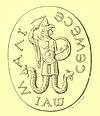Gospel of Eve
| Part of a series on | |||
| Gnosticism | |||
|---|---|---|---|
 | |||
| History | |||
| Proto-Gnostics | |||
| Scriptures | |||
|
|||
| Lists | |||
| Related articles | |||
The Gospel of Eve is an almost entirely lost text from the New Testament apocrypha, which may be the same as the also lost Gospel of Perfection. It is not part of the canonical Bible.
The only known content from it are a few quotations by Epiphanius (Panarion, 26), a church father who criticised how the Borborites used it to justify free love, by practicing coitus interruptus and eating semen as a religious act. While certain libertine Gnostics held that, since the flesh is intrinsically evil, one should simply acknowledge it by freely engaging in sexual acts, the majority of the Gnostics took the opposite view of extreme asceticism.
Text
Gnostics typically wrote on multiple levels, imbuing texts with complicated mystical esoteric meaning, rather than intending a base interpretation. It is possible that Epiphanius failed to realise this and only read into the text a simple literal interpretation. The quotation Epiphanius claims is a reference to semen is:
I stood on a lofty mountain and saw a gigantic man, and another, a dwarf; and I heard as it were a voice of thunder, and drew nigh for to hear; and He spake unto me and said: I am thou, and thou art I; and wheresoever thou mayest be I am there. In all am I scattered [that is, the Logos as seed or “members”], and whencesoever thou willest, thou gatherest Me; and gathering Me, thou gatherest Thyself.— From the Gospel of Eve, quoted by Epiphanius, Hæres., xxvi. 3.[1]
While this second passage from their "apocryphal writings," says Epiphanius, was meant to represent the menstrual cycle (it is unclear if he is quoting Revelation 22:2):
I saw a tree bearing twelve manner of fruits every year, and he said unto me, This is the tree of life ...[2]
Interpretation
According to the Naassenes, this reflected the "Seeds disseminated into the cosmos from the Inexpressible [Man], by means of which the whole cosmos is consummated."[3] The scattering of the Logos and its subsequent collection recalls the myths of Osiris and Dionysus. A similar theme of Osirification is present in a Gospel of Philip, quoted by Epiphanius in the same chapter:
I recognised myself, and gathered myself together from all sides; I sowed no children for the ruler, but I tore up his roots, and gathered together [my] limbs that were scattered abroad; I know thee who thou art, for I am from the realms above.[4]
The reference to thunder is curious—see also The Thunder, Perfect Mind.
References
- ↑ Mead, G.R.S (1906). "The Popular Theurgic Hermes-Cult in the Greek Magic Papyri". Thrice Great Hermes: Studies in Hellenistic Theosophy and Gnosis. Volume I. London and Benares: The Theosophical Publishing Society. p. 85.
- ↑ Williams, Frank (1987). The Panarion of Epiphanius of Salamis. Book I (Sects 1-46). Leiden; New York; København; Köln: E.J. Brill. p. 86.
- ↑ Hippolytus, Philosophumena 5, from Mead, G.R.S (1906). "The Myth of Man in the Mysteries". Thrice Great Hermes: Studies in Hellenistic Theosophy and Gnosis. Volume I. London and Benares: The Theosophical Publishing Society. p. 74.
- ↑ Mead, G.R.S (1900). "Some Forgotten Sayings". Fragments of a Faith Forgotten. London: The Theosophical Publishing Society. p. 600.